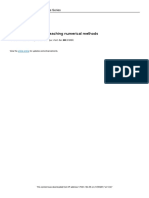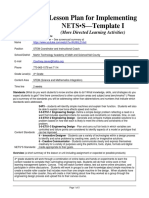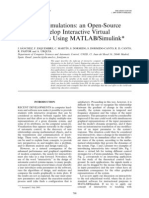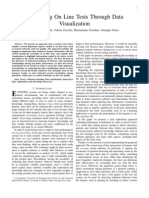Labview: An Interactive Teaching Tool For A Differential Equations Class
Labview: An Interactive Teaching Tool For A Differential Equations Class
Uploaded by
Gurpreet SinghCopyright:
Available Formats
Labview: An Interactive Teaching Tool For A Differential Equations Class
Labview: An Interactive Teaching Tool For A Differential Equations Class
Uploaded by
Gurpreet SinghOriginal Title
Copyright
Available Formats
Share this document
Did you find this document useful?
Is this content inappropriate?
Copyright:
Available Formats
Labview: An Interactive Teaching Tool For A Differential Equations Class
Labview: An Interactive Teaching Tool For A Differential Equations Class
Uploaded by
Gurpreet SinghCopyright:
Available Formats
Labview: an Interactive Teaching Tool for a Differential Equations Class
Asad A. Salem, Ph.D. Mufid Abudiab, Ph.D. Abstract It is evident that computer based learning has become an essential part of education systems. It provides animation and interactive processes that are not possible with textbooks. Not only does LabVIEW have a great impact on industry, it also dramatically affects traditional academic research and teaching. A LabVIEW-based laboratory makes researchers more productive and improves the way students learn. Rather than focusing on sometimes-tedious methods of gathering data, educators and students can focus on results and concepts. In this paper, we present an Interactive Internet application of LabVIEW in computer based teaching and learning, with emphasis on the domain of differential equations applied to physical sciences. The students experiment component is supported with both virtual and real-time remote laboratory. The discussions include the design, implementation plan, and instructional method. Keywords: Interactive Internet based learning, Computer assisted instruction, LabVIEW, JAVA, HTML, Virtual Laboratory, Visualization, Simple Harmonic Motion, Simple Pendulum, Differential Equations. Introduction Along with the advancement of computers and the advent of the Internet, the field of education has taken on new dimensions. This new technology includes Internet based research and learning and serves well as complimentary tools in education. In this paper, we develop an interactive web based activity that is aimed at teaching differential equations concepts through applications in physical sciences and problem solving to college juniors and seniors. It involves the development of an interactive web-based learning environment for basic differential equations concepts. The major objectives are: students understanding enhancement, problem-solving skills improvement, and instructional theories and methods enrichment. Differential Equations is an area where engineering students find difficulties in understanding basic concepts, solving problems and applying them to different fields. This is due to several reasons that include the tedious nature of theory such as the use of higher order differential equations, and the analysis of systems of differential equations [5, 7]. There have been several attempts to employ available technology and World Wide Web to resolve various problems encountered by students [3, 4]. The basic design includes guide, simulation/visualization, web-interaction, and help sessions. The guide provides expert opinions to students. It guides them on topics relevant to solving the problems. The simulation and visualization sector is very important in areas such as differential equations where many tools and methods are not easy to follow and comprehend. In our teaching method, students get enough chances to solve the problems. The implementation will be achieved using HTML, graphical Journal of Mathematical Sciences & Mathematics Education 1
programming language G (LabVIEW), and Internet Developers Toolkit for G. Some visualization simulations will use JAVA applets that are programmed to pop up in a new window. LabVIEW makes it easy to provide both virtual and remote laboratory experiments to students. Clients with passwords could access this tutoring/learning system, including the virtual and remote laboratories, via a web browser in any computer (without LabVIEW application) connected to the Internet. There are several research groups working on computer based learning systems that employ LabVIEW [3, 8, 6, 4]. This paper presents the component of the tutoring system that involves the Internet application of LabVIEW for Virtual Lab and real-time remote laboratory experiments. Fundamental Issues In designing the framework for an interactive computer/Internet based learning instructional systems and intelligent systems, there are fundamental issues that need to be addressed. These issues surround the communication of knowledge to the student. In designing computer assisted instruction and Internet based tutoring systems one needs to consider the domain, student, communication strategies, and the interface. The design of the path/navigation through the proposed interactive internet based computer-assisted instructional system is shown in Figure I. This is a modification of the structure presented by Shute and Psotka [9, 6]. Figure I The design of the path/navigation through an interactive internet based computer assisted instructional system Domain/Curriculum
Present Problem
Expert Solution
Student Solution
Compare Solutions
Evaluate Student
Present Feedback Journal of Mathematical Sciences & Mathematics Education 2
The Domain Knowledge It is necessary to have excellent expertise in the domain of instruction in order to be a good source of the knowledge to be presented. The organization of the knowledge for easy communication to the student, and for best representation and understanding of concepts and their applications are important. In the domain of differential equations, the knowledge to be conveyed to the student must be organized to avoid misconception of abstract and invisible concepts such as resonance, steady state, damping, etc. Knowledge of the Students It is important to understand the behavior of the student, previous knowledge and experience of the student that might affect his/her learning characteristics, and the adaptability to the instructional system. Building knowledge about the student need appropriate diagnostic techniques. In differential equations for example, preliminary questions and problems could be used in assessing the students previous knowledge and experience. One could identify any misconceptions by analyzing the students response to questions and problems. This will be useful in determining the next set and level of problems, the type of visualization aids and simulation of concepts, and the method of materials presentation. Pedagogical Knowledge Communication strategies are important part of the set up. In differential equations, one must be sure that the way materials are presented will not lead to misconceptions. This is important in using animation for visualization purposes. One must exercise good judgment in deciding when, where, and how to present animation JAVA applets, virtual laboratory experiments, and real-time remote lab experiments. Good communication skills however need good understanding of the materials to be presented, the audience or recipient, and the available interface or means of communication. Interfaces with the Students The interface component also need knowledge of the above three components. For example in direction fields, the knowledge about the student will determine if graphical presentation will be adequate or there will be need for animated JAVA applet images. Some other questions may include how problems, responses and feedbacks are handled; how many interactive windows are needed; and should a pop-up new window used? These are few of the many issues that need to be addressed. Design and Implementation The basic design includes guide, simulation/visualization, web-interaction, and help sessions. The guide provides expert opinions to students via MOODLE interactive software using Virtual Lab and real-time remote laboratory. In LabView, we can solve ODEs using one of seven Variable Integrals (VIs) for solving first and higher order Journal of Mathematical Sciences & Mathematics Education 3
differential equations. Most of the vibrations encountered in engineering applications can be represented by a simple harmonic motion. Many others, although of a different type, can be approximated by a simple harmonic motion, provided that their amplitude remains small. The three main applications are simple pendulum, spring mass system, and AC circuit. We demonstrate the Lab View approach using a simple pendulum, consisting of a bob of mass m attached to a cord of length l, which can oscillate in a vertical plane. At a given time t, the cord forms an angle with the vertical. The objective of the following exercise is to demonstrate the solution of a second-order differential equation. We show in this exercise how to incorporate the Substitute Variables VI in order to vary the model parameters. The pendulum model is given by
d 2 g + c d + sin = 0 , dt 2 ml dt l
(1)
where m is the mass of the bob, l is the length of the rod, g is the acceleration due to gravity, and is the angle between the cord and a vertical line passing through the equilibrium position. The model is a homogeneous, linear, second order differential equation. LabView gives us three choices of integration VIs: ODE Cash-Karp 5th Order, ODE Euler Method, and ODE Runge-Kutta 4th Order. However, these three integration VIs are suitable for first-order systems. The first step is to convert the pendulum model to a system of two first order differential equations. Applying the substitution: x1= and x2 =
to equation (1) gives the system
x1
x
c
x 2 = ml x2
g sin x1 . l
(2)
Figure II is the front panel of the VI that simulates the motion of the simple pendulum. Figure II Simulating the motion of a pendulum-front panel
Journal of Mathematical Sciences & Mathematics Education
Furthermore, a block diagram that can be used as a guide in the VI development is shown in Figure III. To begin the development, we use the ODE Euler Method VI. The inputs that will be needed are X (an array of strings listing the dependent variables x1 and x2), time start (the point in time at which we start the calculations t0=0), time end (the point in time at which to end the calculations tf = 6), h (the time increment at which we perform the calculations h= 0.01), and X0 (the initial conditions x1(0) =1, and x2(0) =0). The pendulum differential equations are typed in the F(x, t) control. The VI uses the Substitute Variables VI as a vehicle for varying the pendulum parameters. This allows students to enter the pendulum model on the front panel and then to substitute numerical values for m, l, g and c. Students can change these values to further investigate the effect of these parameters on the system response. In addition, students can, also, change h (step rate) from 0.01 to 0.1. The system response is no longer stable. Since nothing has changed with the physical model, so this instability must be due to the limitation of Euler integration scheme. Therefore, students will have more than one chance and tool to solve the problem at hand. These tools are either analytic or numeric. Figure III Simulating the motion of a pendulum block diagram
Journal of Mathematical Sciences & Mathematics Education
Conclusion The framework for an Internet based tutoring/learning system that uses LabVIEW to present an experiment in the domain of differential equations have been designed .The experiments component is a hybrid of a virtual lab and a real time remote laboratory. Authorized user from a web browser via the Internet could access both labs. The basic design of the remote lab of the motion of a simple pendulum has been presented to demonstrate how LabVIEW and its Internet Toolkit can be used to implement the virtual laboratory. Also, differential equations analysis tools are included in the virtual lab component. This tutoring system will serve as an excellent compliment to classroom teaching and learning of Differential Equations. Our ultimate goal is to design more labs in the differential equations area and to extend this idea to other mathematics courses. Asad A. Salem, Ph.D. Texas A&M University-Corpus Christi, TX, USA Mufid Abudiab, Ph.D. Texas A&M University-Corpus Christi, TX, USA Refrences [1] Abudiab M., The Impact of Technology on Teaching an Ordinary Differential Equations Course, The Journal of Computing in Small Colleges, Volume 16, Number 3, March 2001. [2] Abudiab M., The Interfacing of Mathematica with a Variety of Computing Environments, The Journal of Computing in Small Colleges, Volume 17, Number 5, April 2002. [3] Bachnak R., Steidley C., and Resendez K., Virtual Experiment in Data Acquisition, Display, and Monitoring, Proceedings of the 2003 ASEE Gulf-Southwest Annual Conference, American Society for Engineering Education, 2003. [4] Bishop, Robert, LabVIEW 7 Express, Prentice Hall, 2006. [5] Boyce William E., and DiPrima Richard C., Elementary Differential Equations and Boundary Value Problems, 8th edition, Wiley 2005. [6] Egarievwe Stephen E. et all, Internet Application of LabVIEW in Computer Based Learning, Center for Internet Based Education and Research, EURODL 2000. [7] Laboratory Approaches in Undergraduate Mathematics, Poster Session Funded from NSF through the Undergraduate Educations Instrumentation and Laboratory Improvement, 1994. [8] Resendez K. and Bachnak R., LabVIEW Programming for Internet-Based Measurements, The Journal of Computing in Small Colleges, Volume 18, Number 4, April 2003. [9] Shute V.J., Psotka J., Intelligent Tutoring Systems: Past, Present, and Future. Handbook of Research on Educational Communications and Technology. D. Jonassen (Ed.). Scholastic Publications, 1995.
Journal of Mathematical Sciences & Mathematics Education
You might also like
- The Lego Mindstorms Ev3 Discovery BookDocument5 pagesThe Lego Mindstorms Ev3 Discovery BookPrapussorn Sresanunwong13% (8)
- Internet Application of LabVIEW in Computer Based LearningDocument10 pagesInternet Application of LabVIEW in Computer Based LearningjgkrishnanNo ratings yet
- Computers in Science Education: Dr. Vasant D. BarveDocument9 pagesComputers in Science Education: Dr. Vasant D. BarveNikhil SoodNo ratings yet
- Proceeding On The Computer Education Issue (Pedagogy and Technology)Document165 pagesProceeding On The Computer Education Issue (Pedagogy and Technology)jailaniNo ratings yet
- Mass Spring SystemDocument25 pagesMass Spring SystemKhoironSyamdatuNo ratings yet
- BOLLEN, Lars & JOLINGEN, WR - SimSketch Multiagent Simulations Based On Learner-Created Scketches For Early Science EducationDocument9 pagesBOLLEN, Lars & JOLINGEN, WR - SimSketch Multiagent Simulations Based On Learner-Created Scketches For Early Science EducationCelso GonçalvesNo ratings yet
- "Teach Yourself" Signal Processing at University College LondonDocument10 pages"Teach Yourself" Signal Processing at University College LondonMekaTronNo ratings yet
- U3L1 KnowledgebuildupDocument5 pagesU3L1 KnowledgebuildupSidjay A. PaulinoNo ratings yet
- A Method For Knowledge Representation To Design Intelligent Problems Solver in Mathematics Based On Rela-Ops ModelDocument22 pagesA Method For Knowledge Representation To Design Intelligent Problems Solver in Mathematics Based On Rela-Ops ModelNguyễn TấnNo ratings yet
- 1 s2.0 S184564545650911002663 MainDocument10 pages1 s2.0 S184564545650911002663 Mainelhabib kahlaNo ratings yet
- Smart Teacher: A Modern Information Technology of E-Learning SystemDocument21 pagesSmart Teacher: A Modern Information Technology of E-Learning SystemHU ReadersNo ratings yet
- A Strategy For Realization of Distance Learning System: DR Ružica Stanković DR Ranko PopovićDocument5 pagesA Strategy For Realization of Distance Learning System: DR Ružica Stanković DR Ranko PopovićСузана Вујовић МарковићNo ratings yet
- ICKEDS06 Portugal Mai2006Document6 pagesICKEDS06 Portugal Mai2006SergioRamosNo ratings yet
- Learn Teach Analytical Geometry On A SpreadsheetDocument9 pagesLearn Teach Analytical Geometry On A SpreadsheetKamran JavedNo ratings yet
- Web-Based Course Materials For Engineering Statics: Paul S. Steif, Anna DollárDocument9 pagesWeb-Based Course Materials For Engineering Statics: Paul S. Steif, Anna DollárLouhabAberbourNo ratings yet
- Predicting and Interpreting Student Performance Using Ensemble Models and Shapley Additive ExplanationsDocument16 pagesPredicting and Interpreting Student Performance Using Ensemble Models and Shapley Additive ExplanationsSergio AlumendaNo ratings yet
- OASIcs ICPEC 2022 5Document10 pagesOASIcs ICPEC 2022 5AnnNo ratings yet
- Paper 3Document3 pagesPaper 3RakeshconclaveNo ratings yet
- 3 Easy JavaJavaScript Simulations As A Tool For LearDocument7 pages3 Easy JavaJavaScript Simulations As A Tool For LearCarlos terceroNo ratings yet
- 22n01f0031-Identifying Student Profiles Within Online Judge Systems Using Explainable Artificial IntelligenceDocument40 pages22n01f0031-Identifying Student Profiles Within Online Judge Systems Using Explainable Artificial IntelligenceKalyan Reddy AnuguNo ratings yet
- Bjelica 2018Document9 pagesBjelica 2018Daniel CifuentesNo ratings yet
- Excel Spreadsheet in Teaching Numerical MethodsDocument8 pagesExcel Spreadsheet in Teaching Numerical MethodsJoshua Allen AjetoNo ratings yet
- Programming For Civil and Building Engineers Using MatlabDocument9 pagesProgramming For Civil and Building Engineers Using MatlabNafees ImitazNo ratings yet
- Monitoring Online Tests Through Data VisualizationDocument12 pagesMonitoring Online Tests Through Data VisualizationRahul Reddy PakalaNo ratings yet
- Robotics: Enhancing Pre-College Mathematics Learning With Real-World ExamplesDocument18 pagesRobotics: Enhancing Pre-College Mathematics Learning With Real-World ExamplesAlgeir Prazeres SampaioNo ratings yet
- Teaching Numerical Methods For Non Linear Equations With Geogebra Based ActivitiesDocument13 pagesTeaching Numerical Methods For Non Linear Equations With Geogebra Based ActivitiesMycas MycasNo ratings yet
- Minor RP (Final)Document12 pagesMinor RP (Final)harshitNo ratings yet
- Pes Ieee Usa Jul2008Document7 pagesPes Ieee Usa Jul2008SergioRamosNo ratings yet
- 7345-Article Text-35859-2-10-20210903Document12 pages7345-Article Text-35859-2-10-20210903shaveen84No ratings yet
- Research On Online Learning Resource Recommendation 2020Document8 pagesResearch On Online Learning Resource Recommendation 2020imranNo ratings yet
- Employing Live Scripts For Implementing Virtual Laboratories and ActivitiesDocument14 pagesEmploying Live Scripts For Implementing Virtual Laboratories and ActivitiesFayçal BEN HMIDANo ratings yet
- Cam and Follower PDFDocument3 pagesCam and Follower PDFManivannan JeevaNo ratings yet
- MATH302Document16 pagesMATH302lad08757No ratings yet
- Get Solution Manual for Fundamentals of Logic Design 7th Edition by Roth Free All Chapters AvailableDocument47 pagesGet Solution Manual for Fundamentals of Logic Design 7th Edition by Roth Free All Chapters Availablemireiagosebo100% (1)
- Mathematica ManualDocument157 pagesMathematica Manualjf2oo6100% (1)
- Thesis by Publication UnimelbDocument6 pagesThesis by Publication Unimelbserenafayenewyork100% (2)
- Virtual Interactive Laboratory Applied To High Schools ProgramsDocument6 pagesVirtual Interactive Laboratory Applied To High Schools ProgramsJc GarciaNo ratings yet
- Teaching and Learning in STEM With Computation, Modeling, and Simulation Practices: A Guide for Practitioners and ResearchersFrom EverandTeaching and Learning in STEM With Computation, Modeling, and Simulation Practices: A Guide for Practitioners and ResearchersNo ratings yet
- The Application of Computer Aided Learning To Learn Basic Concepts of Branching and Looping On Logic AlgorithmDocument10 pagesThe Application of Computer Aided Learning To Learn Basic Concepts of Branching and Looping On Logic AlgorithmIJMAJournalNo ratings yet
- 1 Tpack Intsructional Design and Analysis1Document6 pages1 Tpack Intsructional Design and Analysis1rumana pathanNo ratings yet
- Drawing Diagrams in An Online Examination: Pete ThomasDocument12 pagesDrawing Diagrams in An Online Examination: Pete ThomasRan ReddyNo ratings yet
- Lesson Plan For Implementing NETS - S-Template I: (More Directed Learning Activities)Document5 pagesLesson Plan For Implementing NETS - S-Template I: (More Directed Learning Activities)api-338504614No ratings yet
- Easy Java Simulations An Open SourceDocument16 pagesEasy Java Simulations An Open SourceArturo RodriguezNo ratings yet
- International Journal of Engineering Research and DevelopmentDocument6 pagesInternational Journal of Engineering Research and DevelopmentIJERDNo ratings yet
- Treatment ReportDocument9 pagesTreatment Reportapi-738142500No ratings yet
- Rough DraftDocument18 pagesRough Draftapi-552406099No ratings yet
- L B P E L PLC S I PLC S D A: Aboratory Ased Roject FOR Xperiential Earning IN Ystems Ntegration and Ystems ATA CcessDocument5 pagesL B P E L PLC S I PLC S D A: Aboratory Ased Roject FOR Xperiential Earning IN Ystems Ntegration and Ystems ATA CcessPinnn2No ratings yet
- Group 2 Research ManuscriptDocument51 pagesGroup 2 Research ManuscriptAngelica AlfonsoNo ratings yet
- Minor RP (Final)Document12 pagesMinor RP (Final)harshitNo ratings yet
- Hands On Statics To Improve Conceptual Understanding and Representational CompetenceDocument13 pagesHands On Statics To Improve Conceptual Understanding and Representational CompetenceMitzelder Ahn MajilangNo ratings yet
- Educational Data Mining: A Case StudyDocument8 pagesEducational Data Mining: A Case StudyAathiraja KrishnamoorthyNo ratings yet
- Monitoring On Line Tests Through Data VisualizationDocument12 pagesMonitoring On Line Tests Through Data VisualizationShweta MahajanNo ratings yet
- Atcm 2021 97Document16 pagesAtcm 2021 97john3712wickNo ratings yet
- Art 12 - Asynchronous Learning Model in An ODLDocument6 pagesArt 12 - Asynchronous Learning Model in An ODLTokyNo ratings yet
- Ttl1 Activity 12 (Loberiano)Document5 pagesTtl1 Activity 12 (Loberiano)Loberiano GeraldNo ratings yet
- Hclark Lessonplantemplate-IstefinalDocument6 pagesHclark Lessonplantemplate-Istefinalapi-253519526No ratings yet
- Electronic Course Material On Data Structures and AlgorithmsDocument5 pagesElectronic Course Material On Data Structures and AlgorithmsMs. Meenakshi G M MCA. Associate ProfessorNo ratings yet
- Pathways to Machine Learning and Soft Computing: 邁向機器學習與軟計算之路(國際英文版)From EverandPathways to Machine Learning and Soft Computing: 邁向機器學習與軟計算之路(國際英文版)No ratings yet



























































